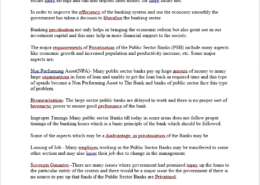The internationalization of the rupee is not without risk, despite its many benefits. Talk about it. (Answer in 150 words)
Priority Sector Lending (PSL) mandates increased lending by the banks towards specified sectors and activities in the economy, which may not get timely and adequate credit in the absence of the special dispensation. Presently, categories under priority sector include Agriculture; Micro, Small and MeRead more
Priority Sector Lending (PSL) mandates increased lending by the banks towards specified sectors and activities in the economy, which may not get timely and adequate credit in the absence of the special dispensation. Presently, categories under priority sector include Agriculture; Micro, Small and Medium Enterprises; Export Credit; Education; Housing; Social Infrastructure; Renewable Energy; and Others. The rate of interest on PSL loans is charged as per the directives of the RBI.
Challenges with Priority Sector Lending in India:
- Sectoral issues: Doubling credit to PSL in the agricultural sector leads to an increase of just 11% of total credit in the agricultural sector as compared to 76% in the export sector and 41% in manufacturing sector. Also, agricultural sector’s susceptibility to vagaries of monsoon increases the credit risks of banks under PSL.
- Lethargy in lending: Most public sector banks have been continuously underperforming on the total priority sector target. This may be due to difficulty in finding viable options to lend to the rural areas or the MSME sector.
- Rising NPA: The Second Narasimham Committee (1998) observed that directed credit led to an increase in non-performing loans and adversely affected the efficiency and profitability of banks. It stated that 47% of all non-performing assets have come from the priority sector.
- Costs of PSL in India: It hinders the banks from expanding their scale of lending, consequently, affecting the banking industry and the flow of credit in the economy as a whole. It also impacts the general lending power of banks and deposit rate, which ultimately impact the general public.
Notwithstanding the challenges, PSL has proved useful for the following reasons:
- Promotes equity: It promotes social equity and facilitates increase in employment and investment in less developed regions and gives an impetus to the vulnerable sections of the society.
- Balanced development: Direct lending allows the commercial banks to generate high social returns along with profits and it also contributes to economic development by increasing investment in strategic sectors like exports.
- Credit formalisation: It increases institutional credit (including commercial banks, cooperative banks and societies) to the agriculture sector compared to non-institutional credit (such as money lenders).
Despite the challenges, the policy of priority sector lending (PSL) target has benefitted the vulnerable sections of society, which though creditworthy, are unable to access the formal banking system for adequate and timely credit. In this context, to make the PSL policy more effective, various steps such as Priority Sector Lending Certificates, timely revised guidelines by the RBI, continued increase of the target under PSL year-on-year, etc. have been taken, which are steps in the right direction.
See less


In the process of internationalization of the rupee it comes with the multiple advantages like reduction in the dependence on the US dollar, enhancements in the globally trading Indian businesses and the most important strengthening of our economy. Promoting the rupee will also reduce the transactioRead more
In the process of internationalization of the rupee it comes with the multiple advantages like reduction in the dependence on the US dollar, enhancements in the globally trading Indian businesses and the most important strengthening of our economy. Promoting the rupee will also reduce the transaction costs which will benefit the Indian importers and the exporters.
But with every shift comes risk. Increasing exposures to financial markets globally can lead to greater unpredictability because the rupee would be more influenced by the international economical fluctuations. This would lead to higher inflation rates which will destabilize our domestic economy. Additionally the Indian financial system will face challenges in managing the liquidity as well as the exchange rate risks as we have relatively less developed financial infrastructure compared to other global currencies.
Furthermore, there’s also the risk of revengeful measures from the other powers of the economy which will perceive this internationalization of the rupee as an upcoming threat to their economy.
In conclusion, while internationalization of the rupee offers a variety of benefits but it comes with greater and parallel risks as well, so it requires careful management and risk mitigation techniques pre – planned to ensure that the advantages overpowers potential economic instabilites.
See less